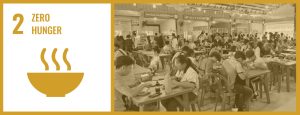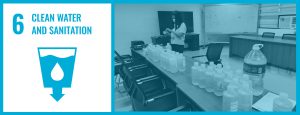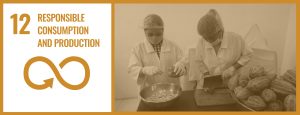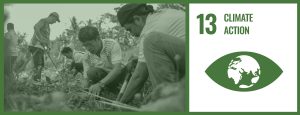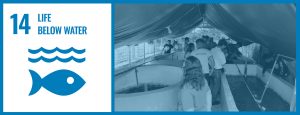2024 Research | SDG 3 – Good Health and Well-Being
Research Programs
Masculinity and Emotional Expression of Military Men
Proponent: Helena B. Florendo
Abstract
Masculinity in the military may cause psychological damage due to the culture of toughness since they are restrained to express their emotions. The general objective of this study is to analyze the relationship between the participants’ masculinity and their emotional expression. Descriptive correlational research design was used among the 80 participants in 5th Infantry (STAR) Division at Camp Melchor F. Dela Cruz, Upi, Gamu, Isabela. The questionnaires consist of the Conformity to Masculine Norms Inventory-22 (CMNI-22) to determine the level of conformity to masculine norms and the Emotional Expressivity Scale (EES) to determine the level of emotional expression of participants. Results revealed that the level of conformity to masculine norms of the participants is moderate non-conformity. The participants’ attitudes towards emotional expression is reasonable. There is a significant relationship between the participants’ conformity to masculine norms and emotional expression. It is also recommended that the human resource or the training unit of the military may consider designing programs regarding the stereotypes surrounding men and emotional expression to help them reduce stress, anxiety, improve relationship, and to help them respond effectively.
Integrating Ecopsychology: Path to Climate Change Mitigation
Proponent: Mary Grace O. Gumpal
Abstract
Human activities have significantly impacted Earth’s ecosystems, presenting a complex issue with diverse causes and consequences. At the core of this problem is human behavior. Although there is widespread concern about climate change, attitudes alone are unreliable predictors of future actions due to the influence of various factors. This study aims to bridge the gap between environmental attitudes and behaviors in the community by introducing the principle of ecopsychology, which explores the relationship between humans and nature and investigates why people destroy their habitats. A mixed-method research approach, specifically an explanatory sequential design, is employed to examine the psychological barriers preventing people from translating their pro-environmental attitudes into concrete actions. Barangay leaders of the BIDANI community initially participated in a survey measuring awareness, experiences, environmental attitudes, and self-reported pro-environmental actions. The results indicate that the participants are highly aware of climate change, its effects, and mitigation strategies. However, due to ingrained habits and attitudes, they are not taking the necessary actions and are waiting for others to lead. By addressing these psychological grassroots, we can better mitigate the effects of climate change. The findings provide valuable insights for future efforts to align pro-environmental attitudes with behaviors through planned interventions, ultimately reducing the impact of climate change.
Project: Upscaling of Postharvest Processing and Shelf-Life of Oyster Mushroom Study: Processing of Mushroom Loaf
Proponent: Melody E. Lim, Arlene I. Remigio, Ma. Leonila Cabaccan
Abstract
This study aims to evaluate the acceptability of mushrooms as a meat substitute in loaf and siomai. The products were assessed based on appearance, flavor, texture, aroma, and overall acceptability, and a cost-return analysis was conducted for each treatment. Data were analyzed using a Randomized Complete Block Design (RCBD). Results revealed that the experimental treatments using pure mushrooms demonstrated comparable attributes – appearance, flavor, texture, aroma, and general acceptability – to the control group, with the 30 panelists rating them as “like very much”. However, the aroma of loaf made with varying proportions of mushrooms was not comparable to the control, receiving a “like moderately” rating. The highest net income was achieved in the pure mushroom treatment (T4), which the panelists rated as “likely slight”.
Project: Upscaling of Postharvest Processing and Shelf-Life of Oyster Mushroom Study: Processing of Mushroom Steamed Dumpling
Proponent: Melody E. Lim, Arlene I. Remigio, Ma. Leonila Cabaccan
Abstract
This study presents the results of a sensory evaluation conducted to assess the attributes of oyster mushroom gyoza, with participation from 50 evaluators. The gyoza were evaluated based on five sensory attributes: appearance, aroma, texture, taste/flavor, and general acceptability, using a 1-9 hedonic scale where 1 indicates ‘dislike extremely.” The results demonstrated that the gyoza had a mean appearance score of 7.6, indicating favorable visual appeal. Aroma received a mean score of 7.2, suggesting general appreciation but less impact on the overall experience. The texture was highly rated with a mean of 7.8, showcasing a successful combination of the soft wrapper and tender filling. The taste/flavor emerged as the standout attribute, achieving a mean score of 8.3, reflecting strong satisfaction attributed to the umami-rich filling of the oyster mushrooms. The overall acceptability score of 8.0 confirmed that the gyoza were well-liked by the evaluators. The findings highlight the strong visual appeal, favorable texture, and particularly satisfying flavor of the oyster mushroom gyoza, establishing them as a successful plant-based alternative to traditional meat-filled dumplings.
“From Orchard to Bottle: Exploring the Potential of Locally Available Fruits for Sustainable Wine Production and Indigenous Vegetables for Mixed Juice Drink”
Proponent: Honeylyn D. Farala
Abstract
Fruits and vegetable are recognized as fundamental source of nutrients. The research study was conducted to determine the acceptability, marketability and nutritive value of locally fruit wine and mixed juice drink. The 9-point hedonic scale and 7-point hedonic scale was used to determine the acceptability level of mixed juice drink of wines and 5-point Likert scale for marketability of the wine and juice. The analyzation results of one-way classification of the Analysis of variance (ANOVA) showed that pomelo wine has a grand weighted mean ranging from 6.68 to 6.80, The turnip wine 6.74 to 6.75, mango wine showed varied ratings in which food experts (grand weighted mean = 6.51) and community people (6.50) and FSM students (6.36). The pineapple wine, has grand weighted mean score ranging from 6.61 to 6.74. This indicates that all the wines are acceptable in three group of respondents. Lastly, for the pipino wine, it received the lowest rating in which it received a rating ranging from 5.99 to 6.36 categorized as only acceptable. For mixed juice drink receives very acceptable in terms of appearance, color, aroma, and taste and extremely acceptable in terms of texture. For the marketability of the study, it is revealed that it has very high potential in the market.
“Innovative Approaches to Processed Meat Production: Improving Quality, Safety, and Sustainability”
Proponent: Mary Grace C. Buraga
Abstract
The study addresses the growing consumer awareness and negative perceptions surrounding processed foods by innovating healthier and more acceptable alternatives using locally sourced ingredients. Conducted in response to findings by the International Food Information Council, which indicated that 43% of primary grocery shoppers view processed foods unfavorably, this research focuses on developing innovative processed meats. Using banana stem as a natural flavor enhancer for longganisa and substituting traditional ingredients in tocino with pineapple wine and calamansi extract, the study employs a descriptive experimental method to evaluate product acceptability. Respondents, including food and service management faculty, community members, and food producers, assessed the products based on appearance, color, aroma, taste, and texture using a seven- point Hedonic rating scale. The analysis, using weighted mean, aims to identify nutritional content and determine shelf life. Results shows that the acceptability of innovative processed meats, specifically tocino and longganisa, using locally sourced ingredients to address consumer concerns about processed foods are well-received by the consumers. The sensory attributes of appearance, color, aroma, taste, and texture were assessed by three groups: FSM students, food experts, and community members. Tocino was highly rated across all sensory criteria,with community members giving the highest overall acceptability score (Grand Weighted Mean = 6.20). Longganisa also received positive ratings, particularly from FSM students (Grand Weighted Mean = 6.03), although food experts rated its appearance and texture as slightly acceptable. The study demonstrates that both tocino and longganisa are well-received by consumers, with potential for market success. The findings highlight the importance of natural flavor enhancements and minimal processing in meeting consumer expectations for healthier processed food options. This approach not only offers a sustainable model for food innovation but also supports local economies through the use of indigenous raw materials.
Acceptability of Slender Amaranth, Lemon Grass and Philippine lime as mixed juice drink
Proponent: Honelyn D. Farala
Abstract
This study evaluates the acceptability of three-juice drinks formulated from slender amaranth, lemongrass, and Philippine lime, focusing on sensory attributes such as appearance/color, aroma/odor, taste/flavor, and texture. Three different treatments were assessed by respondents using a 9-point hedonic scale. The results indicate high acceptability across all treatments, with mean scores ranging from 7.82 to 8.61, all falling within the “Like Very Much” category. Treatment 3 emerged as the most preferred
formulation, achieving the highest mean scores for appearance/color (M = 8.46), aroma/odor (M = 8.44), and texture (M = 8.61). One-way ANOVA revealed significant differences in taste/flavor (F = 5.830, p = 0.004) and texture (F = 4.254, p = 0.016), favoring Treatments 2 and 3 over Treatment 1. Post hoc analysis using Tukey’s multiple comparison test confirmed these differences, with Treatment 1 rated significantly lower in taste and texture compared to Treatments 2 and 3. The findings suggest that specific mixture ratios enhance sensory properties, particularly for Treatments 2 and 3. The high acceptability ratings indicate strong potential for these formulations as commercially viable products. Treatment 3 should be prioritized for further refinement and promotion as a premium offering within the market. The study provides valuable insights for product development and marketing strategies aimed at enhancing the appeal of functional beverages, ultimately contributing to their success in a competitive market.
“Nutritive Values of Slender Amaranth and Lemon Grass with Philippine Lime”
Proponent: Honelyn D. Farala
Abstract
The study aimed to determine the nutritive value and shelf life of slender amaranth, lemon grass and Philippine lime aqueous extract mixed juice drink. The product consisted
of three treatments, treatment 1 150 grams of slender amaranth, 100 grams of lemon grass and 200 grams Philippine line, treatment 2 100 grams of slender amaranth, 150 grams
lemon grass, 200 grams Philippine lime, and treatment 3 50 grams of slender amaranth, 200 grams of lemon grass, 200 grams Philippine lime. The nutritional value of the study
underwent a process and assessment conducted by the Department of Science and Technology (DOST) III and found out that there are ____________________________________________________. The study revealed that mixed juice drinks stored at room temperature have a longer shelf life. The study showed that the mixed juice drink has market potential.
“Marketability of Slender Amaranth and Lemon Grass with Philippine Lime”
Proponent: MACARIO Q. TAMUNDONG JR.
Abstract
The study aimed to determine the marketability of Slender Amaranth and Lemon Grass with Philippine Lime. The product consisted of slender amaranth, lemongrass, and Philippine lime with different formulation. The descriptive – experimental method of research was used with the survey questionnaire as the main data gathering instrument. The
study used five-point Likert rating scale to evaluate the marketability. The statistical tools used in the study were weighted mean and ANOVA. The findings indicate that all
treatments are perceived positively across the respondent groups. However, there are no statistically significant differences in consumer demand, supply availability, or production
costs among the three treatments, as all p-values exceed the conventional threshold of 0.05. Lastly, the treatment 3 being the most favored formulation due to its higher mean scores across all evaluation criteria.
“A Taste of Passion: Acceptability of Coconut Curd (Latik) Macaroons”
Proponent: Ma. Theresa R. Respicio
Abstract
The study aimed to determine the acceptability of banana cake, carrot cake and macaroons. The experimental method of research was used with the survey questionnaire as the main data gathering instrument. The study used the nine-point Hedonic rating scale in evaluating the product’s acceptability in terms of appearance, color, aroma, taste and texture. Twenty (20) Food and Service Management students, twenty (20) food experts, and twenty (20) community people a total of sixty (60) were the respondents of the study. The statistical tools used in the study were weighted mean and standard deviation. Results of the study revealed that the Macaroons had the highest acceptability and with consistent rating across all the respondents, thus it indicates that the coconut macaroons have the potential to be a viable and appealing local product in the market. Meanwhile the acceptability of the banana cake was also very high which indicated that it could also be a dependable option. However, with regards to the carrot cake, refinement and adjustment are needed to meet community people’s preference while not affecting the positive perception of the FSM student and food experts. In the aspect of nutritional content, all baked products
“Application of simple nutrient plus vermi tea on high-value crops for NFT hydroponics system under controlled climatic condition.”
Proponents: Franklin A. Samonte, Marion Caraui, Mark Joseph Reyes
Abstract
Application of simple nutrient plus vermi tea on high-value crops for NFT hydroponics system under controlled climatic condition. Based from the result of the research study, the develop hydroponics system was feasible to design and develop a small-scale hydroponics system every locally and commercially available materials. The respondents concur and accept the design and construction, aesthetic, technical operation, relevance of the study of small-scale hydroponics system. Application of simple nutrient plus vermi tea 75 % and 100 % were enhanced the growth and development of lettuce as manifested on the yield per plant. The return of investment was obtained in the due to low electricity consumption and the production lettuce under develop hydroponics applied with Simple Nutrient plus Vermitea was obtained in T2 – 100 % of SNAP + Vermitea = 295.60%.
Ybanag Traditional Cuisine: Basis for the Development of a Menu Guide
Proponent: DR. JOSEPHINE LUBO
Abstract
The Ybanag people represent one of the indigenous groups in Isabela, Philippines, alongside the Yogads, Itawes and Gaddangs. Apart from these tribes, the Cagayab Valley region is home to various others, each with its own distinct language, including the Itawis, Irrayas, Gaddangs, Yogads, Ilongots, Negritos, and Igorots. The Ybanags predominantly inhabit the Northern coastal towns of Pamplona, Claveria, Abulug, Appari, and Buguey,as well as Camalaniugan, Lallo, and Gattaran in the province of Cagayan. Additionally, they can be found in the towns of Cabagan, San Pablo, Sta. Maria, Tumauini, Ilagan, Gamu, and certain areas in Sto. Tomas, San Mariano, Angadanan, and Reina Mercedes within the Province of Isabela. This study aimed to document the indigenous foods of the Ybanags, which are gradually disappearing due to modernization and enculturation. As these foods fade away, so do the associated meanings, beliefs, and practices attach to them. By understanding their indigenous foods, we can bridge the gap between the Ybanags’ past generation and the present. The study employed a mixed-method approach, combining descriptive-quantitative research mwethods. It involves 108 Ybanag, incliding 36 cooks, 18 restaurant owners 24 tourism staff, and 30 indigenous people. Data collection utilized survey questionnaires and documentation. The foods were documented, and the elders provide insights into the health and social meanings and beliefs associated with these foods. Frequence and percentages were analyzed. The findings revealed that several native foods of the Ybanags, including Pancit Cabagan (Pansi), Binallay, Inatata (Bala-bala) Bebengka (Bibingkang kanin), Nilupra (Inupra), Dinengdeng (Zinendeng), Pinataro, and Corn coffee. The social life and physical health of the Ybanags have long been intertwined with their traditional foods. However, many of these foods and practices are increasingly threatened by the influences of modernization and development, posing a serious risk to their traditional culture and heritage.
Perceived Risks and Effects of Heat Stress to Students and their Coping Strategies
Proponent: Bondee L. Peñaflor, PhD, Beverly Gay N. Cambri, PhD
Abstract
The study assessed the perceived risks and effects of heat stress to students and their coping strategies which could serve as input for policy and institutional innovation in the school. A cross-sectional survey research design was employed in this study covering 583 respondents. Data were analyzed using both descriptive and inferential statistics. Results show that the perceived risk with the highest weighted mean are: I am afraid that hot weather during these days can cause me an injury or sickness; People exposed to heat have a greater risk of developing serious diseases; and Heat is a potentially lethal risk. Meanwhile, the perceived effects of heat stress with the highest weighted mean is Tiredness/Exhaustion, followed by difficulty in getting sleep resulting in decrease in hours of sleep, and due to excessive heat, they were not able to study well at home and in school. To address these effects, foremost of the coping strategies of the students is by drinking cold water, juice or carbonated drinks, and also keeping a personal tumbler to keep drinking water. In addition, students wear comfortable clothes to enhance thermal comfort and bathe more frequently to cope with heat stress. They also utilized trees and parks as the preferred places to stay or resting space for thermal comfort during hot days. Finally, the students were satisfied (weighted mean ranging from 4.11 to 4.26) on the school’s efforts in addressing the effects of heat stress. The study on the Perceived Risks and Effects of Heat Stress to Students and their Coping Strategies aligns well with the United Nations Sustainable Development Goals (SDGs), particularly in the areas of good health and well-being (SDG 3), quality education (SDG 4), and climate action (SDG 13).
The Self ACES of Students in their Tertiary Education Journey: Basis for Enhancement of Student Welfare Programs
Proponent: Margie P. Vinasoy, Beverly Gay N. Cambri
Study 1: Self- Adjustment of First Year Students: Guide for Developing College Adjustment Program
Study 2: Self- Care Habits and Social Connectedness of College Students
Study 3: The Emotional Stability and Academic Success of Working College Students
Abstract
The project, The Self ACES of Students in their Tertiary Education Journey: Basis for Enhancement of Student Welfare Programs, explores three distinct studies aimed at understanding key factors affecting the well-being, adjustment, and success of college students. The overarching goal of the project is to identify areas for enhancing student welfare programs to better support student development during their tertiary education. This project aligns with the achievement of SG3 and 4.
Study 1: Self-Adjustment of First Year Students: Guide for Developing College Adjustment Program
This study examined the self-adjustment challenges faced by first-year students at Isabela State University-Cabagan Campus, with a focus on sex differences. The sample comprised 327 students, of whom 58.72% were female and 41.28% male. It was revealed in this study the prevalence of adjustment concerns, with interpersonal problems being the most common (92.35%), followed by career-related issues (44.95%), academic challenges (43.43%), and self-esteem concerns (34.86%). Family problems (22.32%), anxiety (21.1%),
depression (12.84%), and substance abuse (12.01%) were also reported, while suicidal ideation, though less common, affected 6.73% of students. Sex differences were found in
self-esteem issues and substance abuse, with male students reporting higher levels of both. Male students also showed more vulnerability to substance abuse, reflecting trends in coping mechanisms for stress. This study also revealed significant relationships between sex and all nine adjustment concerns, namely academic problems, depression, suicidal ideation, substance abuse, family issues, and career problems, indicating that sex plays a critical role in how students navigate these challenges. These findings underscore the importance of developing sex-sensitive support services to address the distinct needs of male and female students, such as self-esteem workshops for males and substance abuse prevention programs.
Keywords: self-adjustment, first-year students, college adjustment program, academic challenges, university transition
Study 2: Self-Care Habits and Social Connectedness of College Students
This study explored the self-care habits and social connectedness of college students, investigating how these variables intersect. Emotional self-care was found to be the most frequently practiced, while students reported a high sense of closeness but lower levels of satisfaction, belongingness, and support in their social interactions. The study found no significant relationship between self-care habits and social connectedness, suggesting that self-care practices may be more individualized and not necessarily reflective of enhanced social engagement. These findings highlight the need for interventions that simultaneously promote personal well-being and foster strong social support systems.
Keywords: self-care habits, social connectedness, college students
Study 3: Emotional Stability and Academic Success Among Working College Students
This study focused on the relationship between emotional stability and academic success among working students. Key personality traits, such as social interaction, trustfulness, self-discipline, and timidity, were analyzed in relation to academic performance. The majority of respondents achieved a general weighted average (GWA) between 1.75 and 2.00, with no students reaching the 1.00 (excellent) or 3.00 (passing) GWA benchmarks. While most dimensions of emotional stability did not significantly correlate with academic performance, traits like distrustfulness and gregariousness were identified as potential influencers, with distrustful students engaging in deeper learning and gregarious students benefiting from social interaction and collaboration.
Challenges and Difficulties: Teaching General Education Curriculum During and Post Pandemic
Proponent: Sheila Marie D. Sibug & Marines S. Zilabbo
Abstract
This study was conducted to determine the challenges and difficulties encountered by the teachers of General Education Curriculum subjects at Isabela State University City of Ilagan Campus. Based on responses gathered from surveys and relevant literature. Four key themes emerge from the data: Time Management and Stress, Limited Facilities, Emotional and Mental Well-being, and Adaptation, Access, and Institutional Support. Teachers reported difficulties in managing time effectively due to adapting to new learning formats and schedules during the pandemic, compounded by stressors such as technical issues and limited facilities. Emotional and mental well-being emerged as significant concerns, particularly post-pandemic, as the transition to remote learning and associated stressors impacted both teachers and students. Moreover, access to necessary resources, including internet connectivity and gadgets, was highlighted as essential for overcoming challenges. Institutional support, such as providing internet connections and scheduled reporting, was also noted as crucial in addressing some of the challenges faced by teachers. The findings align with existing literature, indicating similar challenges reported by teachers globally during the pandemic. Recommendations for strengthening the distance education system include bolstering infrastructure, providing access to resources, and offering psychological support and in-service training for educators. Thus, the study revealed the challenges faced by teachers during and post-pandemic and underscores the importance of institutional support in navigating these challenges effectively.
TEACHING ENGLISH THROUGH ENGLISH: EXPLORING ANXIETY IN NON-NATIVE PRE-SERVICE ESL TEACHERS
Proponent: Sheila Marie D. Sibug
Abstract
This study explores the factors influencing anxiety levels among pre-service ESL teachers of Isabela State University City of Ilagan Campus when teaching and speaking in English. Through thematic analysis of responses from pre-service ESL teachers, several key themes emerged. Fear of judgment and criticism, perfectionism, preparation and knowledge, social anxiety and comparison, performance pressure, concerns about classroom management, and negative feedback and reactions were identified as influential anxiety factors.
The findings also underscore the multifaceted nature of anxiety in ESL teaching and speaking through analyzing a 24-item statements on factors affecting the level of anxiety of the preservice teachers ESL teachers revealing a weighted mean of 3.26, describes as “moderately agree” these have been influenced by various psychological, linguistic, and situational factors. Building confidence and adopting a positive mindset, practicing and preparation, accepting mistakes and constructive feedback, gradual exposure, and providing support were identified as potential strategies to overcome anxiety in the ESL classroom. In addition, the study highlights the importance of understanding and addressing anxiety in ESL contexts to support pre-service ESL teachers in developing their language proficiency and teaching skills. Implementing effective strategies to manage anxiety can contribute to creating a supportive learning environment conducive to language acquisition and teacher professional development.
Further research and practical interventions are warranted to explore the efficacy of these strategies in mitigating anxiety and enhancing teaching effectiveness in ESL settings.
Knowledge, Attitudes and Practices Towards Water Sanitation and Hygiene among Household Residents in Flash Flood Prone Areas in the City of Cauayan, Province of Isabela, Northern Philippines
Proponent: Paul Angelo A. Tamayo, Marisol S. Foronda, & Lorelei C. Tabago
Abstract
This study explored the knowledge, attitudes, and practices towards Water, Sanitation, and Hygiene (WASH) among households in flash flood-prone areas of Cauayan City, Isabela, Philippines. Given the susceptibility of the area to flash floods, investigating their KAP in WASH is crucial in preventing disease outbreaks. A crosssectional, non-experimental research design was used and 100 household members were selected through purposive sampling from selected barangays. A questionnaire adapted from UNICEF to obtain information on hand washing, solid waste management, sanitation, and treatment of drinking water. Findings revealed that most households understand key handwashing practices is washing hands before eating with 91.59%. However, knowledge gaps exist regarding hand hygiene before breastfeeding and water treatment. While most respondents use latrines, open defecation persists among children under five. Additionally, waste management practices and reliance on external water sources present concerns, especially during floods. The study underlines the need for the provision of an enhanced flood preparedness plans focusing on improving WASH practices and infrastructure, particularly in vulnerable communities. Recommendations include increasing outreach and education efforts and improving sanitation systems to mitigate health risks in flood-prone areas.
Fuzzy Logic Approach in Predicting Egg Production on Laying Hen in an Uncontrolled Temperature
Proponent: Dr. Cherry R. Gumiran
Abstract
The primary factors influencing egg production in hens are age, body weight, feed intake, and quality. However, heat stress and disease are significant factors that can negatively impact egg production, leading to economic losses and affecting egg quality, weight, and shell quality. To address these issues, a fuzzy logic model was developed using the Mamdani style, incorporating six input variables: age, body weight, feed intake, feed quality, temperature, and disease. The model aims to predict the egg production rate of individual hens, particularly in uncontrolled temperature environments and categorizes the output into three levels: low, medium, and high. The model consists of 486 rules that quantify the relationships between the input and output variables. Studies have shown that temperature is the primary factor affecting egg production, particularly in uncontrolled temperatures. When the temperature exceeds the normal range, it can significantly impact the hen’s appetite, leading to a reduction in egg production. However, if the input variables are within the standard ranges, excluding age, the rate can still be high even for young hens (20-30 weeks old).
Internet Gaming Reduction Intervention Program (I-GRIP): Efficacy in Managing Excessive Gaming Behavior among Filipino Student Gamers
Proponent: MArris R. Reyes
Abstract
Technological advancements come with significant negative impacts on individuals’ mental health. One of which is gaming disorder – a pattern of gaming behavior (“digital-gaming” or “video-gaming”) characterized by impaired control over gaming, increasing priority given to gaming over other activities to the extent that gaming takes precedence over other interests and daily activities, and continuation or escalation of gaming despite the occurrence of negative consequences (ICD-11). Numerous treatment programs have been implemented yet, they seldom lead to success. This study designed and implemented an intervention program that is anchored to the BASIC-ID of multimodal therapy, the cognitive-behavioral model of gaming disorder, and the E-Loop of IGD that primarily aimed to manage the behavioral addiction of symptomatic student gamers. The validated program Internet Gaming Disorder Intervention Program was implemented using a true experimental design. Forty participants were randomly assigned into the experimental (20) and control group (20). Data were analyzed using a t-test – for the difference between pre-and post-test and factorial mixed ANOVA – for the effect size. Results showed significant differences between the pre – and post-test scores of the 2 groups. Further, effect size indices implied that they are highly effective in reducing overall and specific symptoms.


